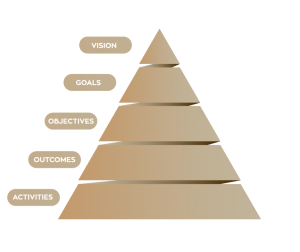What is Strategic Planning?
The future success of your organisation depends on effective strategic planning.
Strategic planning is the process of establishing and documenting a direction of your organisation by envisioning where you want your business to be in the future as well as assessing where it is now.
This leads to the creation of a formal document – the strategic plan – that lays out the company’s views and goals for the future and the action plans you will use to move your organisation from where it is to where you want it to be.
The Structure of the Strategic Plan
 The structure of the strategic plan is shown in the diagram where we can see that everything is aligned to help the organisation achieve its strategic goals and vision.
The structure of the strategic plan is shown in the diagram where we can see that everything is aligned to help the organisation achieve its strategic goals and vision.
Here we can how the strategic goals are supported by organisational goals and objectives. The strategic activities should be aligned with the objectives, operational goals, etc. It is important that people understand that the activities are being undertaken to achieve the desired outcomes.
At a lower level (not shown in the diagram), strategic activities will be deconstructed into detailed projects and actions. This will form the basis of the business plan. and will set out what needs to be done to attain the organisations goals and vision.
Advantages of Strategic Planning
Focusing on the long-term strategy of your business is essential. Strategic planning is as important as having a business plan and can lead to the success of your business. You and your employees will understand the current status of the company, productivity will increase as everyone works toward achieving the business goals and will put it in a better position to address any potential issues that may come up in the future.
An increasing number of companies use strategic planning to formulate and implement effective decisions. While planning requires a significant amount of time, effort, and money, a well-thought-out strategic plan efficiently fosters company growth, goal achievement, and employee satisfaction because it makes it clear to everyone where it is going and what needs to be done to get there.
This means that management will have a clear understanding of what you want to accomplish and how you are going to achieve that. Communicating this clearly and involving people from all levels in the organisation in the process has many advantages including improved motivation and commitment leading to increased productivity and efficiency.
Involve People
Involving as many people as possible in the process plays an important role in the successful implementation of the plan. This is not to say they everyone needs to be involved at every stage. For example, senior management should be involved in envisioning the future – setting the goals and vison. People at the operational level will have an important input to understanding what needs to be done to achieve the long-term goals. The key is to ensure that the people with the knowledge and skills are involved at the correct phase in the development of the strategic plan.
Our strategy creation process has been specifically designed to encourage participation by all of the relevant people in the organisation. It also creates causal links among each of the elements of the plan which helps build the strategy model shown in the above diagram.
Implementing the Strategic Plan
Creating the strategic plan is not the end, it is just the beginning. The most important part of the strategic planning process is not creating the plan, it is implementing the plan. This requires commitment to and focus on carrying out the strategic plan from everyone in the organisation. Ensuring that the strategic plan is used as the foundation for decision making and activities in the organisation means that people will continue to focus on its direction and goals.
A strategic plan is a living document that should be updated on a regular basis as you learn from implementing it and also as you react to changes in the external environment. There is no predefined timetable for updating your strategic plan – it will depend on your organisation and the market in which it operates. However, reviewing and evaluating your strategic plan regularly (at least one a year) will help keep you on track to achieving your goals.
Reviewing your strategic plan involved testing the assumptions made when developing your strategic plan, checking to determine whether those assumptions were correct. For example, what you thought would be challenges and opportunities when the plan was created may not be the same now. It is important that you do not become too attached to your plan. Don’t be afraid to change any part of the strategic plan if your find that assumptions are wrong or outside factors are having a bigger impact on your business than you initially thought.
